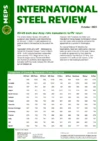Trade defence focus grows as Chinese steel exports rise
Forecasts that China’s domestic steel demand is unlikely to increase in the medium term have highlighted concerns that its growing exports will continue to apply downward pressure to global steel prices.
Earlier this month, United States President Joe Biden suggested that a threefold increase to the existing Section 301 tariff of 7.5% could follow a review of Chinese imports. He accused China of dumping steel into global markets at “unfairly low prices” in an address at the headquarters of the United Steelworkers union.
Chinese material accounts for just 2% of US steel imports, however. Consequently, some MEPS respondents suggest that the effect of increased tariffs on US supply and prices would be minimal.
East Asia’s steel markets are increasingly vulnerable to the effects of Chinese exports. Trade defence measures in Europe and the US, in particular, mean that China’s neighbouring countries are increasingly exposed to any overcapacity.
China’s steel demand outlook
In its latest short-range outlook report, worldsteel forecast that overall steel demand in China had “reached its peak” back in 2020 and would, consequently, remain flat in 2024. Next year would bring a 1% decline in demand, it said. Meanwhile, the state-backed China Metallurgical Industry Planning and Research Institute forecast a 1.7% drop in China’s steel demand this year, following a 3.3% decline in 2023.
According to worldsteel, China has made significant progress in limiting the growth of its domestic crude steelmaking capacity. Its data shows that production climbed by just 0.1% to 1.02 billion tonnes in 2023, following a 14.9% decline in December. China’s National Bureau of Statistics recently reported that production rose by 1.6%, year-on-year, to 168m tonnes, in the first two months of this year.
China’s exports have continued to rise as weak domestic demand persists. In March, the country’s exports increased by 25% to 9.89 million tonnes, their highest level since 2016. This follows the 36% rise in exports in 2023 as a whole.
Pressure on overseas markets
The pressure on Chinese steelmakers to seek out overseas markets is expected to persist as reduced demand from a troubled real estate sector continues to limit domestic consumption. The recent worldsteel report said that 2024’s loss of demand from real estate would be offset by growth from infrastructure investments and manufacturing sectors.
Investment in property developments fell by 9.5% year-on-year in quarter one, however, following a decline of 9% in the previous quarter. Nonetheless, infrastructure investment rose by 6.5% (from 6% in quarter four) as investment in factories and equipment rose by 4.5% (from 4.2%).
A Chinese government notice in early April revealed that new efforts to reduce steel capacity would focus on decarbonisation and the issue of low-quality, low-cost steel. This has led to suggestions that China’s excess steel production capacity could be “moving up the value chain”.
However, MEPS’s China hot rolled coil prices fell to its lowest level since June 2020, during the April research period.

Source:
International Steel Review
The MEPS International Steel Review is an essential monthly publication, offering professional analysis and insight into carbon steel prices around the world.
Go to productRequest a free publication





